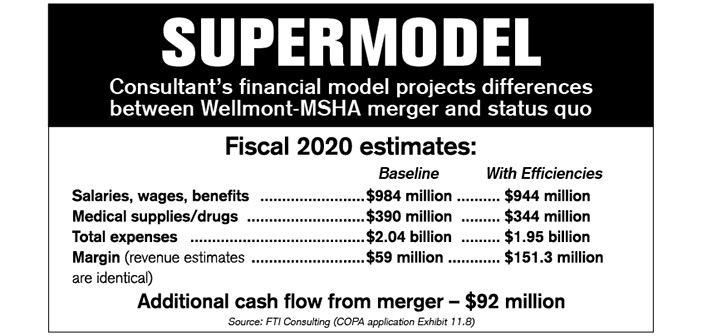By Jeff Keeling
Mountain States Health Alliance and Wellmont Health System’s drive to, as the systems put it, “become better together,” hinges largely on the expectation that efficiencies of a merged system will free up money – lots of it.
The systems’ Feb. 15 application for a Certificate of Public Occupancy (COPA), with “exhibits and attachments,” ran to precisely 2,578 pages. A 14-page section beginning 2,499 pages in provides detail into the group behind projections that a merged system will throw off an extra $120 million or so in annual cash flow once it’s fully integrated.
Those projected margins, the systems say, will then be reinvested into efforts to improve population health, attract the best physicians and workers, and prime the pump for research efforts and the outside dollars those can bring, among other goals.
Monday, Wellmont’s chief financial officer, Alice Pope, and MSHA’s chief operations officer, Marvin Eichorn, briefly discussed the financial projections developed by FTI Consulting. The COPA application’s “Exhibit 11.8” includes a seven-page narrative description of the work FTI did to develop two financial models.
The first is a “baseline” combining anticipated total numbers of the two systems with no efficiencies gained, the second a “preliminary efficiencies” model projecting different expenses due to efficiencies gained. Those savings are projected to begin in the fiscal year ending June 30, 2017, and the models shown in the COPA application project through 2020.
The systems’ COPA application estimated $120 million of annual efficiency savings from a combination of non-labor, labor and clinical efficiencies at full integration. By fiscal 2020, that amount is already projected at $92 million, with baseline expenses of $2.044 billion and a preliminary efficiency estimated expense of $1.95 billion. Projected income from operations is $141.5 million, compared to a baseline model of $49.1 million.
Of that difference, $49 million is projected to go into “expense related to COPA,” a line item not present in the baseline model for 2017-2019, 2020 the three previous years’ COPA-related expenses total about $81.5 million. Ultimately, the merged system intends to invest about $450 million in the first 10 years of integration in mental health, children’s health, research and combatting chronic conditions.
“By the time you get out to 2020, you’re pretty much out to what would be the annual amount for the remaining six years,” Eichorn said.
Many people have raised questions about reductions in personnel since the merger announcement. By 2020, the “salaries, wages and benefits” line item totals $944.9 million – a full $40 million less than the same line item in the baseline model.
Pope said there is a high likelihood, though, that the $49 million in expenses related to COPA will include salaries for new jobs related to the COPA’s endeavors.
“Just to give an example, if we’re going to be expanding services into the behavioral health area, there is a dollar amount allotted to the cost of that expansion … while it’s not 100 percent employment, there’s certainly a very large component of the investment that comes back to the area as employment,” Pope said.
Eichorn added that some of the COPA-related expenses could lead to job creation outside of the merged company.
“If you look at research and graduate medical education, the likelihood for additional employees in the region should be quite a bit, and those will be on the books at ETSU, or (University of Virginia), or Lincoln Memorial or all the other academic and research institutions in our market.
“It’s going to be a combination.”
Pope and Eichorn both said they were happy with FTI’s work (the comparative income statements can be found at jcnewsandneighbor.com/FTI).
“I don’t think either health system would have put forth anything in something as important as these two applications that we’re not able to stand behind and concur with the results and the presentation,” Pope said.
“At the end of the day we’re going to be held accountable … by the state and the community (for) generating the kind of resources it’s going to take to provide these levels of commitments,” Eichorn added. “We feel very good about the work that FTI did.”





